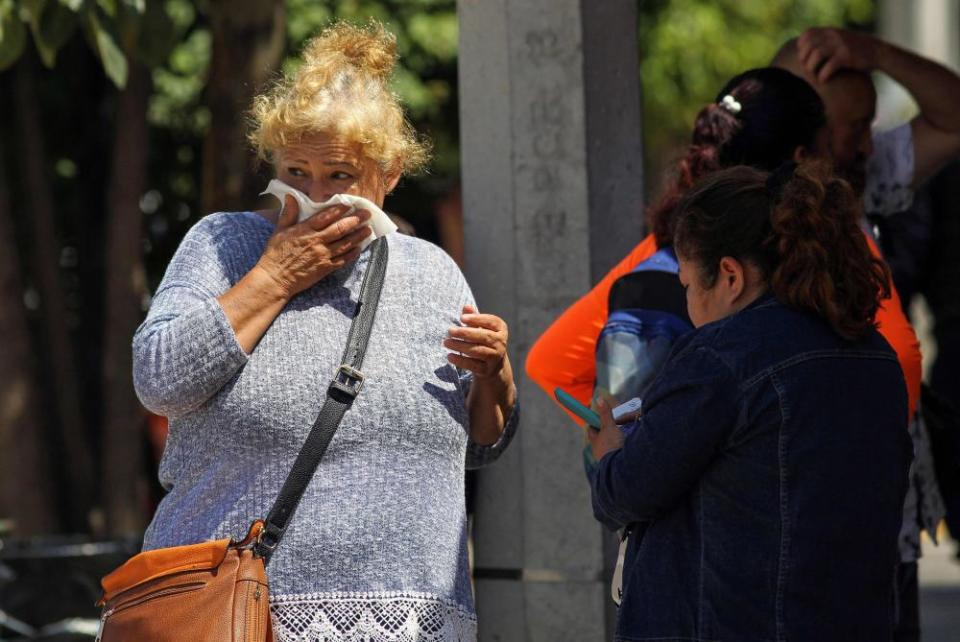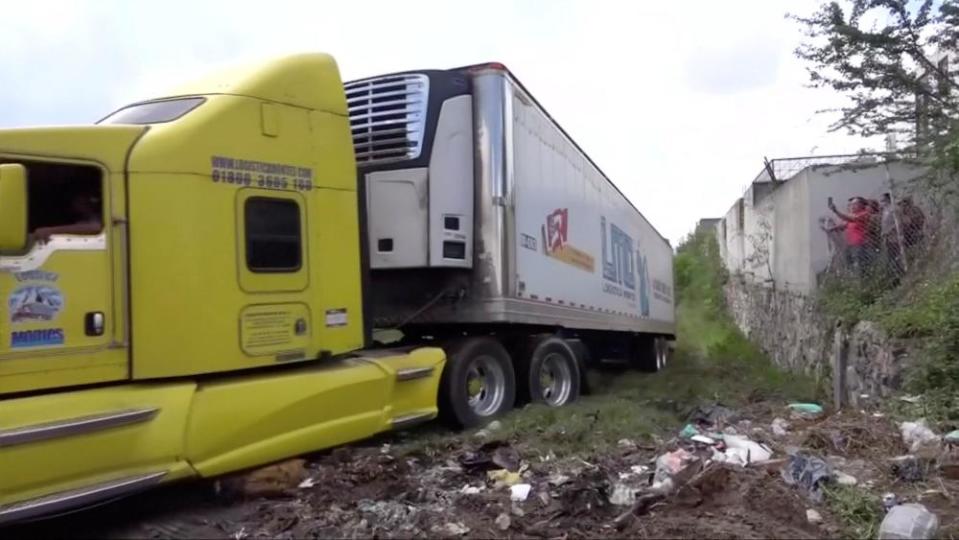'A smell of death:' Mexico's truck of corpses highlights drug war crisis

The first sign something was amiss came when an 18-wheeler lumbered into the dilapidated neighbourhood of Paseos del Valle on the outskirts of Guadalajara.
The truck itself was unremarkable – a white tractor unit pulling a refrigerated tailer emblazoned with a polar bear logo – but it came with a police escort.
And as the massive vehicle pulled onto a muddy track between the last row of houses and a cornfield, dogs across the neighbourhood began to bark wildly at the overpowering stench it released.
“It was a smell of death,” recalled Alejandro Espinosa, a hospital maintenance worker who lives nearby.
A crowd quickly gathered, and when the truck became stuck in the mud, several youths pushed past the police and forced open the trailer doors.
Inside were scores of human bodies, wrapped in garbage bags, bound with duct tape and piled haphazardly on top of each other.
Local authorities eventually confirmed that 273 corpses had been dumped in the trailer after the relentless pace of violent crime left the local morgue without any space for new arrivals. For nearly two weeks, the truck had been drifting around the suburban hinterland of Mexico’s second city.
As the scandal escalated, Jalisco officials were forced to admit that they had been using stationary trailers to store bodies for at least two years.

The macabre discovery came on the country’s national holiday, and seemed to offer a damning comment on the state of the nation: in the 12 years since Mexico launched its militarized war on drugs, more than 200,000 people have died and another 35,000 gone missing.
Shockingly, Guadalajara is not the first city whose morgue has been overwhelmed by the sheer number of dead – although it is by far the largest.
“There are 20 other states with the same problem,” said Octavio Cotero, who was fired as director of the Jalisco Forensic Science Institute (IJCF) after the trailer’s discovery.
But the incident offered a perfect symbol for a crisis which affords no dignity to its victims – and which provokes indifference from the population, and mere expedience from the authorities.
Why did Mexico launch its war on drugs?
On 10 December 2006, president Felipe Calderón, launched Mexico’s war on drugs by sending 6,500 troops into his home state of Michoacán, where rival cartels were engaged in tit-for-tat massacres.
Calderón declared war eight days after taking power – a move widely seen as an attempt to boost his own legitimacy after a bitterly contested election victory. Within two months, around 20,000 troops were involved in operations across the country.
What has the war cost so far?
The US has donated at least $1.5bn through the Merida Initiative since 2008, while Mexico has spent at least $54bn on security and defence since 2007. Critics say that this influx of cash has helped create an opaque security industry open to corruption at every level.
But the biggest costs have been human: since 2007, around 230,000 people have been murdered and more than 28,000 reported as disappeared. Human rights groups have also detailed a vast rise in human rights abuses by security forces.
As the cartels have fractured and diversified, other violent crimes such as kidnapping and extortion have also surged. In addition, hundreds of thousands of people have been displaced by violence.
What has been achieved?
Improved collaboration between the US and Mexico has resulted in numerous high-profile arrests and drug busts. Officials say 25 of the 37 drug traffickers on Calderón’s most-wanted list have been jailed, extradited to the US or killed, although not all of these actions have been independently corroborated.
The biggest victory – and most embarrassing blunder – under Peña Nieto’s leadership was the recapture, escape and another recapture of Joaquín “El Chapo” Guzmán, leader of the Sinaloa cartel.
While the crackdown and capture of kingpins has won praise from the media and US, it has done little to reduce the violence.
How is the US involved?
Mexico’s decade-long war on drugs would never have been possible without the huge injection of American cash and military cooperation under the Merida Initiative. The funds have continued to flow despite growing evidence of serious human rights violations.
“In other parts of the world it would be a bigger scandal. In Mexico it’s another crime story – this time on wheels,” wrote columnist Eduardo Caccia in the newspaper Reforma.
Guadalajara and the surrounding Jalisco state have seen a wave of violence attributed to a split within the upstart Jalisco New Generation Cartel (CJNG), which has also clashed with the Sinaloa Cartel.
Local officials said that they were simply unable to keep pace with the bloodletting; as of last week, 444 bodies were awaiting identification.
“I told the prosecutor: ‘I have nowhere to keep the bodies. They’re already stacked up,’” said Cotero.
So in 2016, the state government started storing bodies in refrigerated trailers. It was supposed to be a stopgap measure, until the completion of a new cemetery.
Construction on the new facility began several months ago, but was stopped after complaints by local residents, according to press reports.
Meanwhile, the first trailer was already full, and authorities were forced to move it, to make space for a second vehicle
At first, the trailer was concealed in a warehouse in the nearby city of Tlaquepaque, but the building had been constructed without permits and the truck was discovered by municipal inspectors.
The vehicle subsequently moved on to Paseos del Valle near Guadalajara airport, where it got stuck in the mud.

The trailer “is just the tip of the iceberg,” said a representative of a Jalisco collective of relatives of missing people, who estimated five state investigators assigned to handle missing persons cases each had around 400 cases files.
Independent congressman Pedro Kumamoto said Jalisco investigators had also been slow to adapt to judicial reforms that introduced oral trials and a presumption of innocence in an effort to steer law enforcement efforts away from coercion and torture.
“[The Jalisco prosecutor’s office] received an enormous number of warnings from the human rights commission,” he added. “It resolved cases through torture and not investigations.”

The “trailer of death” – as it was dubbed by tabloids – came as a final rebuke to outgoing president Enrique Peña Nieto who came to office in December 2012 promising to modernise Mexico, but seemed largely indifferent to the violence.
Jalisco state government – led by Nieto’s ally governor Aristótles Sandoval – faced similar criticism.
“There was always an effort by the government to downplay the security problem,” said Diego Petersen Farah, a columnist with the Guadalajara newspaper el Informador. “They always wanted to hide the problems of security – but it became visible with these trailers.”
Despite its conservative reputation, Guadalajara has been the setting for some of Mexico’s most notorious narco crimes, including the 1985 murder of DEA agent Kiki Camarena and the 1993 assassination of its cardinal Juan Jesús Posadas Ocampoat at the city’s airport.
More recently, it has attempted to recast itself as the Silicon Valley of Mexico, and its city centre has seen a construction boom that some analysts have attributed to a surge in money-laundering.
Mexican politicians are often accused of treating security as a public relations issue; after the fiasco of the trailer, officials in Jalisco defaulted to another familiar tactic: passing the buck.
Sandoval fired the IJCF director the state prosecutor and promised to speed up construction of a new cemetery for unidentified bodies. In turn, Cotero, the ousted forensic chief, blamed the prosecutor’s office for the incident.
“This problem of rising deaths has been going on for three years,” said Cotero.
Amid the row over the truck, Cotero revealed that his own family had fallen victim to Jalisco’s violence: his daughter Indira Cotero, 37, a lawyer, was abducted in July and hasn’t been seen since.
In an interview at his personal office, Cotero seemed defeated. He said the investigation into his daughter’s disappearance had stalled, even though the suspects were known to the authorities.
“They opened a file, made a phone call – and that was it,” he said. “Organised crime rules here – even more than the official authorities. They have the subjugated the government itself.”

 Yahoo News
Yahoo News 
